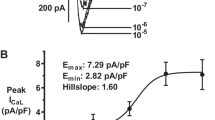Abstract.
Putative β4-adrenoceptors mediate cardiostimulation and arrhythmias in mammalian heart. Both β1- and putative β4-adrenoceptors mediate arrhythmias but through different mechanisms. To elucidate further the mechanisms of cardiostimulation and arrhythmias we measured Ca2+ transients and L-type Ca2+ currents in mouse ventricular myocytes. We used (-)-CGP 12177, an antagonist of β1- and β2-adrenoceptors with agonist properties at the putative β4-adrenoceptor, and (-)-isoprenaline as an agonist for β1- and β2-adrenoceptors. (-)-CGP 12177 increased Ca2+ transients in electrically stimulated cells loaded with Indo-1. The maximum increase of Ca2+ transients caused by (-)-CGP 12177 amounted to approximately one-third of that caused by maximally effective (-)-isoprenaline concentrations. Both (-)-CGP 12177 and (-)-isoprenaline caused concentration-dependent arrhythmic Ca2+ transients. The arrhythmias appeared at paced Ca2+ transients and between paced Ca2+ transients. The arrhythmic potency of (-)-CGP 12177 (–logEC50=9.4) was approximately 40 times greater than that of (-)-isoprenaline (–logEC50=7.8).
L-type Ca2+ current was measured in the whole cell configuration of the patch clamp technique. In the presence of both 3-isobutyl 1-methylxanthine (6 µmol/l) and (-)-propranolol (500 nmol/l), (-)-CGP 12177 (100 nmol/l) increased significantly L-type Ca2+ current by 19% of the effect of (-)-isoprenaline.
The (-)-CGP 12177-evoked increase of Ca2+ transients contrasts with the smaller effects on L-type Ca2+ current, suggesting that activation of the putative β4-adrenoceptor causes a more efficient Ca2+-induced Ca2+ release than activation of the β1-adrenoceptor. β4-Adrenoceptors mediate arrhythmias with smaller Ca2+ transients and smaller increases of L-type Ca2+ current than β1-adrenoceptors, in line with different but still unknown mechanisms as previously suggested for the intact heart.
Similar content being viewed by others
Author information
Authors and Affiliations
Additional information
Electronic Publication
Rights and permissions
About this article
Cite this article
Freestone, N., Heubach, J., Wettwer, E. et al. β4-Adrenoceptors are more effective than β1-adrenoceptors in mediating arrhythmic Ca2+ transients in mouse ventricular myocytes. Naunyn-Schmiedeberg's Arch Pharmacol 360, 445–456 (1999). https://doi.org/10.1007/s002109900075
Received:
Accepted:
Issue Date:
DOI: https://doi.org/10.1007/s002109900075




